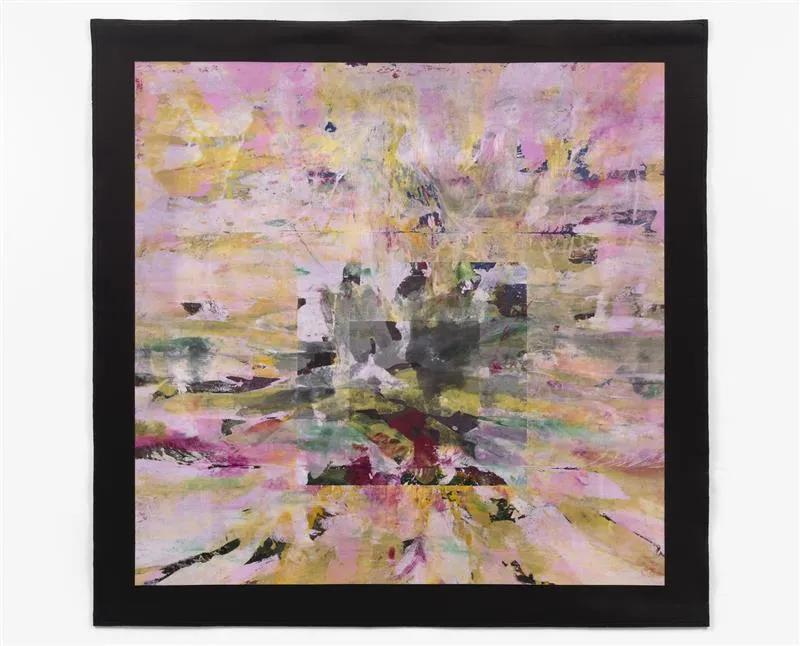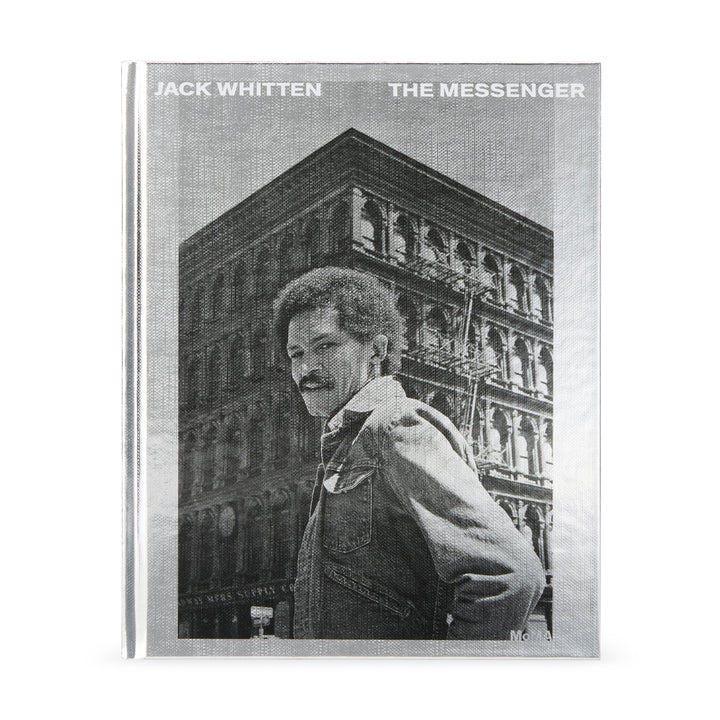
Jack Whitten, Light Sheet I, 1969, acrylic on canvas © Jack Whitten Estate
In Conversation: Michelle Kuo & Julie Mehretu on "Jack Whitten: The Messenger"
In celebration of the recent opening of "Jack Whitten: The Messenger" at The Museum of Modern Art and the release of the accompanying catalogue, please join us at Hauser & Wirth 18th Street for a conversation between MoMA’s Chief Curator at Large and Publisher, Michelle Kuo, and artist Julie Mehretu for a conversation about Jack Whitten’s unceasingly innovative forms of abstraction, and how his daring legacy endures today.
Jack Whitten created visionary beauty from righteous anger. Born in Bessemer, Alabama, and raised in the Jim Crow South in the 1940s, Whitten undertook an extraordinary journey in becoming an artist, convinced that by changing form, he could help change the world. Through his exploration of materials and tools, Whitten invented art-making techniques that were the first of their kind. Through his confrontation with racial prejudice and technological change, he made art matter in a world in turmoil. This retrospective is the first to span all six decades and every medium of Whitten’s revelatory practice, and features paintings, sculptures, and works on paper that reveal how Whitten overturned the tenets of modern art-making to become one of the most important artists of our time.
The MoMA exhibition catalogue, ‘Jack Whitten: The Messenger,’ edited by Michelle Kuo, will be available for purchase during the event, and features contributions by Glenn Ligon, Julie Mehretu, Anna Deavere Smith, Sampada Aranke, Mark Godfrey, Michael Duffy, Annie Wilker, Dana Liljegren, George E. Lewis and Richard Shiff.
We will also be featuring two new publications from Hauser & Wirth Publishers, ‘In the Studio: Jack Whitten,' and the new edition of ‘Jack Whitten: Notes from the Woodshed.’
This event is free; however, reservations are required.
Click here to register.

About Jack Whitten
Jack Whitten’s career is defined by his refactoring of the relationship between art and society. From the upheaval of the 1960s to the end of his life in 2018, Whitten faced great pressure to pursue representational art as a form of activism. Yet he dared to invent forms of abstraction—and offered the world a new way to see.
Born in Bessemer, Alabama in 1939, Whitten came of age in the segregated US South. He attended the Tuskegee Institute as an Air Force ROTC cadet to study medicine, but left after two years to explore art. Following a short period at Southern University in Baton Rouge, Louisiana, where he participated in the Civil Rights movement, Whitten moved to New York in 1960 to attend the Cooper Union for the Advancement of Science and Art. Resolved to become an artist, he began developing novel techniques, many of which were the first of their kind.
In the 1970s, Whitten experimented with pulling layers of acrylic paint across a floor-bound canvas in a sweeping movement, producing a luminous, quasi-photographic blur. Following an artist’s residency at the Xerox Corporation in 1974, Whitten began experimenting with photocopier toner, applying the chemical pigment directly to paper with a flat scraper blade and then setting it with a heat lamp. The resulting surreal, black-and-white registrations resemble technological images despite having been made entirely by hand. In the 1990s, he cut hardened sheets of acrylic paint into thousands of mosaic tiles to assemble richly textured paintings that suggest pixels or galaxies. For decades, Whitten spent his summers in Greece, constructing sculptures that fused the arts of Africa and the ancient Mediterranean with contemporary technologies. He often dedicated his works to figures in Black history, as if he were a messenger—and his art a way of sending meaning out into the world. “I am a conduit for the spirit,” he declared. “It flows through me and manifests in the materiality of paint.”
About Michelle Kuo
Michelle Kuo was appointed Chief Curator at Large and Publisher at MoMA in 2024. She leads innovative, interdisciplinary work on temporary and collection exhibitions, digital initiatives, research and scholarship, and acquisitions for the Museum’s collection, and she directs MoMA’s ambitious global publications program. Kuo joined MoMA in 2018 as the Marlene Hess Curator of Painting and Sculpture. Her exhibitions and collaborations include Jack Whitten: The Messenger (2025), Otobong Nkanga: Cadence (2024–25), New Order: Art and Technology in the Twenty-First Century (2019), Artist’s Choice: Amy Sillman—The Shape of Shape (2020), Amanda Williams: Embodied Sensations (2021), Refik Anadol: Unsupervised (2022), Signals: How Video Transformed the World (2023), Artist’s Choice: Grace Wales Bonner—Spirit Movers (2024), and Montien Boonma: House of Hope (2024). She has written and lectured widely; her publications include Sensing the Future: Experiments in Art and Technology (2024), More than Real: Art in the Digital Age (2018), and numerous essays and articles on the work of Robert Rauschenberg, Fluxus, Jack Whitten, Anicka Yi, and others.
Kuo has taught at Harvard and Yale universities and serves on the advisory board of the Museum Brandhorst, Munich, and the journal October. From 2010 to 2017, she was editor-in-chief of Artforum International. Kuo earned her PhD in the history of art and architecture from Harvard University and her BA from Stanford University. From 2005 to 2007 she was the Wyeth Fellow at the Center for Advanced Study in the Visual Arts at the National Gallery of Art.
About Julie Mehretu
Born in Addis Ababa, Ethiopia in 1970, Julie Mehretu is a world-renowned painter who lives and works in New York City. Mehretu’s practice in painting, drawing and printmaking engage us in a dynamic visual articulation of contemporary experience, a depiction of social behavior and the psychogeography of space by exploring palimpsests of history, from geological time to a modern-day phenomenology of the social.
Mehretu received a Master's of Fine Art with honors from The Rhode Island School of Design in 1997. She is a recipient of many awards, including the The MacArthur Award (2005), the Berlin Prize: Guna S. Mundheim Fellowship at The American Academy in Berlin, Germany (2007) and in 2015 she was awarded the US Department of State Medal of Arts Award. Named TIME’s 100 most influential people of 2020, Mehretu also designed BMW’s 20th Art Car in2024. In 2025, Mehretu was awarded the rank of Officer of the Ordre des Artset des Lettres by the French Ministry of Culture.
A mid-career survey of Mehretu's work recently toured at LACMA (Los Angeles), High Museum (Atlanta) The Whitney Museum of American Art (New York) and The Walker Museum of Art (Minneapolis) from 2019-2023. Her largest European solo exhibition to date entitled, Ensemble, was recently shown at Palazzo Grassi in Venice. Mehretu’s first solo exhibition in Australia at the MCA in Sydney entitled, Julie Mehretu: A Transcore of the Radical Imaginatory, will be on view until the end of April 2024. Mehretu is a member of the American Academy of Arts and Letters, the American Academy of Arts and Sciences, The National Academy of Design and the National Academy of Sciences in Ethiopia. She sits on the board of the Whitney Museum of American Art, is a trustee and alumna of the American Academy in Berlin, a Global Council Member at Zeitz MOCAA, and is co-founder and board member of Denniston Hill. She is represented by Marian Goodman Gallery, White Cube and carlier | gebauer.
UPCOMING EVENTS - New York
1 / 2

